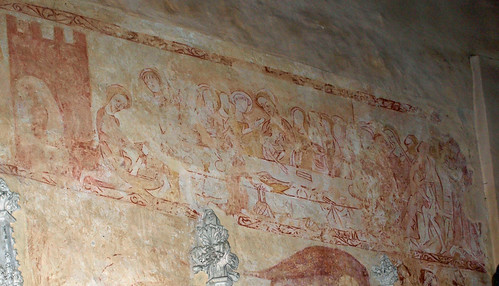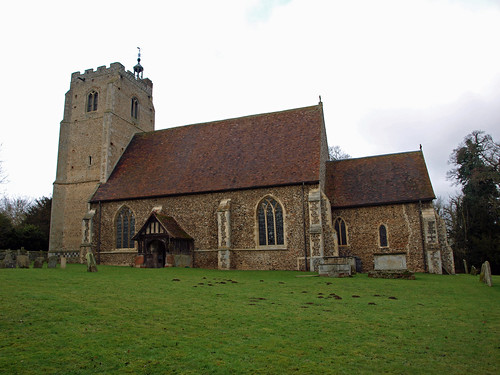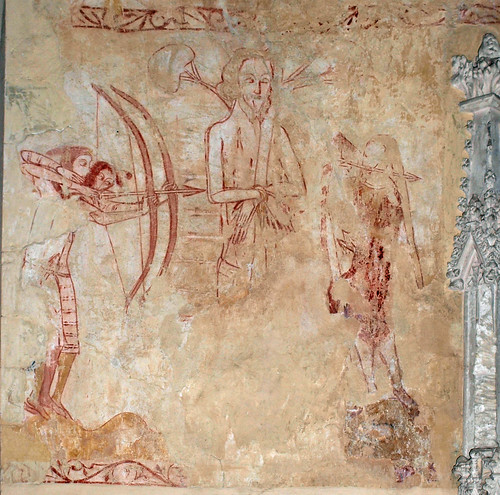St Mary the Virgin is another fine example of Essex church architecture, beautifully situated and has some very fine medieval wall paintings.
The east window is Gothic, but all the glass is Victorian except the tiny topmost light which depicts the Virgin Mary, the window was restored in 1996.
The Raymond family monument, designed and built by Robert Taylor for John Raymond in 1720 is on the north wall of the chancel. Beneath the floor is the later of the two family vaults.
The Chancel Arch is fine and beautifully proportioned.
The nave is is of unusual width for a single span and very lofty. It is of early 14th Century origin.
At the north - east end are the remains of what must have been a very beautiful canopied Chantry Chapel, which evidently extended outside the North wall, and would have incorporated the tomb of the Botetourt family - Sir John de Botetourt having been buried in 1324. Prior to that date he occupied the Manor as underlord of the de Veres — Earls of Oxford, at Hedingham Castle, and Priory of Earls Colne, to whom the church at that time belonged. This memorial was apparently defaced during the Civil War, at which time memorial brasses were also removed from tombs under the Centre Aisle.
Also on the north Wall can be seen Mural Paintings of unusual interest, particularly that of the Madonna to whom the Church is dedicated. Prior to 1962 this painting had been partially visible and in 1962, along with other paintings was restored by an expert who was a Mrs Baker; she was engaged through the auspices of The Pilgrim Trust. Her initial comments regarding the Madonna are as follows “ I discovered a text partially obscuring the painting, which is of 14th Century date. And I cleaned off the text to reveal an extremely lovely painting finely drawn and over life size in scale. It is probably an altar painting, bearing in mind the dedication of the church. I know of no better painting of this subject- it is the most entirely satisfactory treatment I have ever seen".
The Virgin is crowned with her long hair flowing over her shoulders, and she is suckling her Child who is supported on her left knee, with tracings of censing angels on either side and a bird can just be made out on top of the canopy - possible a falcon.
The boldness of the drawing and the treatment of the eyes are typical of the period (14th Century). The long hair is said to have been a sign of virginity but the crown is unusual, although it has been known as far back as the 12th Century when a sceptre was sometimes seen - as Queen of Heaven. The figure at the bottom right of the painting is thought to be the Patron worshipping the Virgin with his beads. The painting is reminiscent of that at Great Canfield in Essex, which is attributed to Matthew Paris, and could well be by the same hand.
The restoration then moved onto the remainder of the North wall where she uncovered two tiers of paintings. These are not by the same painter but nevertheless are interesting, in the top tier there are six subjects, and in the lower tier four subjects, but one of these is very hard to make out. The paintings are mostly in red ochre but also some are in yellow. They can be identified as follows:
Upper Tier - looking from left to right:
1. Christ entering the Gate of Jerusalem on a donkey which is in yellow ochre.
2 The Gate of Jerusalem. A small head is looking down from the battlements. Slight traces of a figure can be seen in the archway.
3 Christ kneeling and washing the feet of Peter.
4 The Last Supper. Judas is seen stealing the bag of money and a fish from the table.
5 The Betrayal, Judas, Christ and two Soldiers.
6 Christ before Pontius Pilate. Christ’s hands are bound and He is blindfolded.
Lower Tier:
l The martyrdom of Saint Edmund. He is bound to a tree and being shot by the
Danes with bows and arrows.
2 This is indecipherable.
3 A large "Pelican in Piety" painted in red, pecking at her breasts and so drawing
blood to feed her five chicks.
4 This subject is in some doubt, but appears to be a King, Queen and a Courtier bearing a Hawk. Perhaps the first part of "The Three Living and the Three Dead”.
In 1964 Mrs Baker came back to look at the South Wall but the results were disappointing. The plaster on this wall being in poor condition, details had become obliterated, but portions of a roundel are seen depicting a figure with arrows and a woman. This is possibly Saint Sebastian, who was wounded with arrows shot at him, the archers leaving him for dead. His wounds were healed by Irene, widow of the martyr Saint Castulus.
Above the South door there appears to be three women with Christ - the Resurrection Scene? Especially as there seems to be a sleeping figure near His right foot.
To the right of the door is an inscription in Old English, this is of a much later date and quotes from the Acts of the Apostles (Chapter 20, verse 9): "And there sat in a window a certain young man named Eutychus, being fallen asleep; and as Paul was long preaching, he sank down with sleep and, fell down from the third loft, and was taken up dead", however the narrative goes on to say he recovered.
In 1996 the whole of the walls containing the paintings was stabilised and cleaned.
The upper part of the Font is Norman.
ST MARY. Chancel, nave, and W tower. The chancel is much lower than the nave and is, by its (renewed) lancer window, E. E. The nave dates from c. 1320 as indicated by the windows with intersected tracery with cusps. C15 timber S porch with pretty bargeboarding. C15 W tower with diagonal buttresses and battlements, a high stair turret and a very tall transomed W window of three lights. The interior of the church rather wildly painted in High Victorian days (restoration 1860) probably by the same craftsman (or firm) who worked at Foxearth. In the nave MONUMENT to Sir John Boutetort d. 1324 or 1325, extremely ornate. Tomb-chest and effigy missing. A big cusped and sub cusped arch flanked by thin buttresses. Fleurons, leaf-branches, bossy leaves, shields serve to enrich the surfaces. Ogee details in the main arch and the cusping, but rather subdued. Also of the C14 the large WALL PAINTING of the Virgin suckling the Child which was discovered in 1926. - FONT. Circular, C12, the bowl damaged along the top. Decoration with beaded scrolls, leaves etc. - MONUMENT. Sir John Raymond d. 1720. With Roman pilasters, two seated cherubs and more cherubs’ heads. Good quality; signed by Robert Taylor Snr.

Mee is succinct -
BELCHAMP WALTER. Among its old houses are St Mary Hall, which was here in the 16th century and has something left of a house 100 years older; the 15th century Hopkins Farm; and Clark’s Farm with a Tudor fireplace, carved bargeboards, and a gabled dormer window. Above the Belchamp Brook stands the church, its 15th century tower with a chequered parapet, the lofty nave 14th century, the chancel 13th. The roofs are 500 years old, and so is the south porch of timber and brick. The font has a round bowl with bands of ornament, the work of a Norman craftsman; and there is an arched recess beautifully carved with flowers and shields, probably the canopy of a tomb of 600 years ago and the entrance to a vanished chantry chapel.
Flickr set.
Simon K.
Here we are in the heart of Lovejoy country. Entirely a Suffolk church I suppose (we are less than a mile from the border), and not terribly attractive perhaps with its low chancel and blockish tower. But the setting makes up for all that, of course, with the Hall, and the woods, and the sheep, and the cottages. I thought this church was very interesting, particularly the wall paintings. It was almost entirely dark inside, and so it was only when I got home that I could really see what they were - very fine indeed. I loved the stone flags as well, shame about the carpets over them.
Simon K.
Here we are in the heart of Lovejoy country. Entirely a Suffolk church I suppose (we are less than a mile from the border), and not terribly attractive perhaps with its low chancel and blockish tower. But the setting makes up for all that, of course, with the Hall, and the woods, and the sheep, and the cottages. I thought this church was very interesting, particularly the wall paintings. It was almost entirely dark inside, and so it was only when I got home that I could really see what they were - very fine indeed. I loved the stone flags as well, shame about the carpets over them.



No comments:
Post a Comment